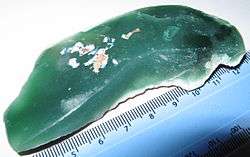Chrome chalcedony
Chrome chalcedony is a green variety of the mineral chalcedony, colored by small quantities of chromium.[4] It is most commonly found in Zimbabwe, where it is known as Mtorolite,[5] Mtorodite,[6] or Matorolite.[7]
| Chrome Chalcedony | |
|---|---|
 Zimbabwean chrome chalcedony (known locally as mtorolite). Scale is in centimetres. | |
| General | |
| Category | Oxide mineral |
| Formula (repeating unit) | Silica (SiO2) |
| Crystal system | Trigonal or monoclinic [1] |
| Identification | |
| Formula mass | 60 g/mol |
| Color | Emerald green |
| Cleavage | Absent [2] |
| Fracture | Uneven, splintery, conchoidal [2] |
| Mohs scale hardness | 6 - 7 [2] |
| Luster | Vitreous, dull, greasy, silky [2] |
| Streak | White |
| Diaphaneity | Translucent [2] |
| Specific gravity | Usually 2.60. Sometimes greater than 2.62 [3] |
Chemical composition
Chrome chalcedony is similar in appearance to the better known chrysoprase, but differs in that whilst chrome chalcedony is colored by chromium (as chromium(III) oxide), chrysoprase is colored by nickel.[4] The two can be distinguished with a Chelsea color filter, as chrome chalcedony will appear red, whilst chrysoprase will appear green.[4][8] Chrome chalcedony (unlike chrysoprase) may also contain tiny black specks of chromite.[3]
Chrome chalcedony is (together with agate, carnelian, chrysoprase, heliotrope, onyx and others) a variety of chalcedony. This is a cryptocrystalline form of silica, consisting of fine intergrowths of the minerals quartz and moganite.[1]
Locality
Chrome chalcedony (known as mtorolite, mtorodite or matorolite) occurs in Zimbabwe, principally near to the mining town of Mtoroshanga, located on the Great Dyke geological feature.[5] It has also been discovered in western Australia, the Balkans, Bolivia, Turkey and the Ural mountains.[9]
Ancient history
Chrome chalcedony was widely used in jewellery and seals throughout the Roman Empire. The source of the mineral is unclear, as whilst Pliny the Elder described it as coming from India, no deposits have been found there. It may have come from Anatolia (in modern-day Turkey), where deposits are known to exist.[9]
Chrome chalcedony disappeared from use sometime in the 2nd century. It was only rediscovered when the Zimbabwean deposits were found in the 1950s.[10]
References
- Heaney, Peter J. (1994). "Structure and Chemistry of the low-pressure silica polymorphs". Reviews in Mineralogy and Geochemistry. 29: 1–40.
- Duda, Rudolf; Rejl, Lubos (1990). Minerals of the World. Arch Cape Press. ISBN 0-517-68030-0 (Reference gives data for chalcedony in general.)
- "Insider Gemologist: What Are the Identifying Characteristics of the Different Varieties of Green Chalcedony?". GIA Insider. Gemological Institute of America. 7 (13). 2005.
- Willing, M. J.; Stocklmayer, S.M (2003). "A new chrome chalcedony occurrence from Western Australia". Gems & Gemology. 23: 265–279.
- Cairncross, Bruce (2005). Field Guide to Rocks & Minerals of Southern Africa. Struik. ISBN 1-86872-985-0.
- Hey, M. H.; Embrey, P. G. (1974). "Twenty-eighth list of new mineral names" (PDF). Mineralogical Magazine. 39 (308): 903–932. doi:10.1180/minmag.1974.039.308.15. Archived from the original (PDF) on 2015-06-10. Retrieved 2009-01-22.
- Hey, M. H. (1970). "Twenty-sixth list of new mineral names" (PDF). Mineralogical Magazine. 37 (292): 954–967. doi:10.1180/minmag.1970.037.292.19. Archived from the original (PDF) on 2015-06-10. Retrieved 2009-01-22.
- O'Donoghue, Michael (2006). Gems. Butterworth-Heinemann. ISBN 0-7506-5856-8.
- Lule-Whipp, Cigdem (2006). "Chromium Chalcedony from Turkey and Its Possible Archeological Connections" (PDF). Gems & Gemology: Proceedings of the 4th International Gemological Symposium & GIA Gemological Research Conference, San Diego, California. 42. p. 115. Archived from the original (PDF) on 2008-09-20. Retrieved 2009-01-22.
- Thoresen, Lisbet. "Ancient Glyptic Art – Gem Engraving and Gem Carving". Archived from the original on 2008-12-26. Retrieved 2009-01-13.